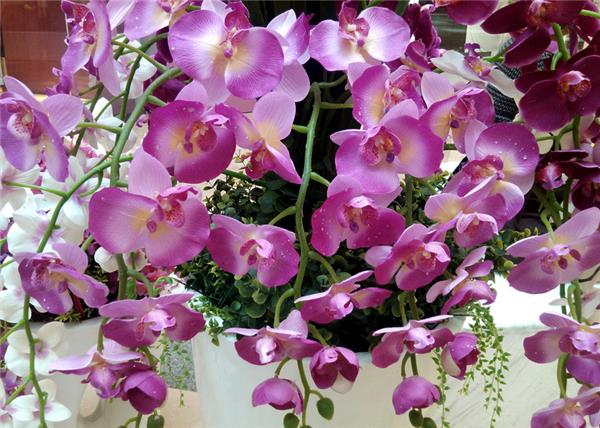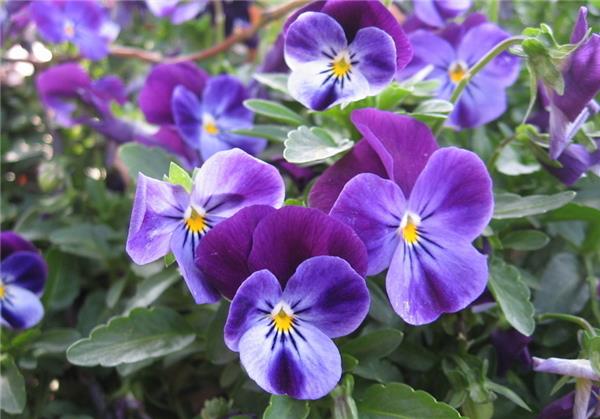How to raise Phalaenopsis, queen of orchids, irrigated with love
How to raise Phalaenopsis? Phalaenopsis, with its beautiful flowers and gorgeous colors, is a treasure of tropical orchids and is known as the queen of orchids. Phalaenopsis is also often used to decorate the living room, so how to keep it? Phalaenopsis, in fact, is not difficult to raise, as long as you have enough patience to do the following steps, let's take a look at how to raise Phalaenopsis.

First, a brief introduction to Phalaenopsis
Its appearance has made it impossible for you to be critical. Butterfly orchid is graceful, elegant and varied, the flower is named after the butterfly, and is widely cultivated all over the world. Although it belongs to aerial orchid, it has no false bead stem, only a very short stem at the base. The leaves are wide and thick, long oval, up to more than 50 centimeters. Some varieties have beautiful light silver mottles on the leaves and purple underneath. Pedicel extracted from leaf axils, slightly curved, varying in length, several to hundreds of flowers, shaped like butterflies, sepals long oval, lip apex trifid, various colors, can blossom for more than a month, more cut flowers abroad, is a high-grade product in Magnolia. Phalaenopsis is a famous species of cut flowers. Phalaenopsis is a single-stem epiphytic orchid with short stems, large leaves, one to several flower stems, arched and large flowers, so named because the flowers are similar to butterflies. With beautiful flowers and gorgeous colors, it is a treasure of tropical orchids and has the reputation of "queen of orchid". Its appearance is beyond the description of language, beyond the embellishment of words, and in my impression, it is beautiful beyond description.
Second, how to raise Phalaenopsis
(1) the maintenance of Phalaenopsis should be divided into two stages, pre-management and post-management. Each different period of time to adjust the maintenance temperature, moisture and pay attention to disinfestation, like the late maintenance of the flowering stage, water and fertilizer management is particularly important. Watering should be carried out at 10:00 to avoid sprinkling water directly on the flowers. After watering, an exhaust fan is used for ventilation to keep the air in the shed fresh and make the residual moisture dissipate as soon as possible. At this time, the best fertilization solution of Huaduoduo 2 (the ratio of nitrogen, phosphorus and potassium is 10:30:20) is 1000 times, depending on the condition of Phalaenopsis itself.
Phalaenopsis is easy to suffer from soft rot and gray spot. Soft rot is very contagious, and the disease strain will be isolated as soon as it is found. The diseased plant can be prevented and treated with manganese zinc or Haoshengling. It is usually sterilized once every 15 days.

(2) when maintaining, we should pay attention to the following problems
1. Watering too frequently will cause root rot. Friends who cultivate Phalaenopsis always worry that Phalaenopsis is short of water, regardless of whether the cultivation medium is dry or not, watering it every day, resulting in serious root rot.
2. Keep the temperature right and don't let it get too low. Usually Phalaenopsis flowering plants on the market in early spring, and after buying home are generally placed in the living room and other places to enjoy, although the day temperature in these places is enough, but the night temperature is slightly too low. On the other hand, most of the professionally cultivated orchids are in well-equipped greenhouses, in contrast, the temperature and humidity at home are not enough, so the growth of the plant tends to weaken day by day. Therefore, sometimes, no matter how well maintained, orchids still do not blossom.

3. Apply a small amount of fertilizer for many times, not too much. Fertilizer is applied as soon as there is fertilizer, and do not pay attention to the concentration. I think that if you apply fertilizer, you will grow faster. It should be noted that Phalaenopsis should be fertilized with thin fertilizer, a small amount of fertilizer for many times. Keep in mind that "replenishment" should not be excessive, or it will be counterproductive.
4. Small flowers use small pots, do not plant small plants in large pots. Some people think that using a large basin can give Phalaenopsis a relaxed environment and sufficient materials. In fact, after using a large basin, the water plant is not easy to dry, it is important to know that Phalaenopsis likes ventilation, ventilation is comfortable.
5. Increase indoor humidity to replenish moisture and avoid dry flowers. Nowadays, Phalaenopsis is mostly driven by flowers. After leaving the base, it is easy to have a dry bag problem after the environment changes. At this time, do not think it is dry, do not water more, but increase the indoor humidity and control the indoor temperature. The temperature can not be too high. Try to buy flowers with thick petals.
6. The light should not be too much. Although Phalaenopsis prefers shade, it is still necessary to make the orchid plant accept some light, especially before and after flowering, the appropriate light can promote Phalaenopsis to blossom and make the flowers gorgeous and long-lasting, generally should be placed indoors where there is scattered light, do not let direct sunlight.

7. Ventilation is very important. The normal growth of Phalaenopsis needs flowing fresh air, so domestic Phalaenopsis must be well ventilated, especially in the high humidity period in summer, it must be well ventilated to prevent heat, and at the same time avoid the infection of diseases and insect pests.
Be sure to use good ventilation to prevent heat, but also to avoid the infection of diseases and insect pests.
Related
- Wuhan Hospital Iron Tree Blooming Result Was Instantly Frightened by the Gardener Master
- Which variety of camellia is the most fragrant and best? Which one do you like best?
- What is the small blue coat, the breeding methods and matters needing attention of the succulent plant
- Dormancy time and maintenance management of succulent plants during dormancy
- Minas succulent how to raise, Minas succulent plant pictures
- What are the varieties of winter succulent plants
- How to raise succulent plants in twelve rolls? let's take a look at some experience of breeding twelve rolls.
- Attention should be paid to water control for succulent plants during dormant period (winter and summer)
- Watering experience of twelve rolls of succulent plants
- Techniques for fertilizing succulent plants. An article will let you know how to fertilize succulent plants.



